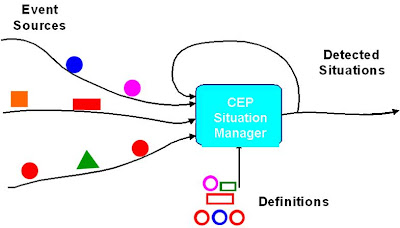2009-01-19T23:26:00.001+02:00
 This drawing, in various forms, has been used by us for many years to illustrate the notion of pattern, actually in the PowerPoint version it is animated, and the geometric shapes are keep moving. The term pattern is a bit overloaded in event processing, as noted my DEBS 2008 tutorial on this topic, but this illustration refers to the pattern which shows some combination of events, to be more accurate it is a predicate on the event history that if evaluated to the value of
This drawing, in various forms, has been used by us for many years to illustrate the notion of pattern, actually in the PowerPoint version it is animated, and the geometric shapes are keep moving. The term pattern is a bit overloaded in event processing, as noted my DEBS 2008 tutorial on this topic, but this illustration refers to the pattern which shows some combination of events, to be more accurate it is a predicate on the event history that if evaluated to the value of
"true" something should happen. This illustration was created by Tali Yazkar-Haham from IBM Haifa Research Lab as an exercise in a presentation course, and was used in dozens of presentations ever since (including presentations of some people outside IBM who typically forgot to give credit to the source).
Paul Vincent, in a continuous debate with Tim Bass, on the complex events forum, has written about "detection of new instance" and "detection of new type". While these terms make sense, I prefer not to overload the term detection and use the terms event pattern detection and event pattern discovery.
Pattern detection deals with detection that a predefined pattern has happened. This is what illustrated in the picture above. Some example can be: a patient is hooked up to a heartbeat monitor, and the physician is pre-setting a pattern "the heartbeat is monotonically increasing within 10 minutes, and the amount of increase is more than 30 during that period". This is actually a predicate over a part of the event history of a single source and type (other examples can involve multiple sources and types, but the principle is the same).
 So event pattern detection is defined as detection that a predefined patterns has occurred.
So event pattern detection is defined as detection that a predefined patterns has occurred.
This is equivalent to what Paul called: Pattern instance Detection.
In contrast, when we talk about event pattern discovery we mean that the pattern is not known in advance, and the pattern discovery function determines what is the pattern. The legend says that Archimedes discovered his famous laws about floating bodies when sitting in the bathtub and shouted: Eureka (this illustration was taken from the homepage of a company who has the word Eureka in its name, again animated in the source).
 A pattern can be discovered by machine learning techniques using decision trees, statistical modeling, Bayesian Networks and numerous other methods. At the end when a pattern is discovered then it also need to be detected in reality; there are also cases in which there is a continuous detection since the patterns are changing after a short time.
A pattern can be discovered by machine learning techniques using decision trees, statistical modeling, Bayesian Networks and numerous other methods. At the end when a pattern is discovered then it also need to be detected in reality; there are also cases in which there is a continuous detection since the patterns are changing after a short time.
Getting back to the previous example about the heartbeat, it may be the case that this pattern has bot been set by a physician, instead it was detected by some method that has looked at past events and found out that this pattern has some significance.
Most people thinking about "complex event processing" are actually talking about pattern detection, regardless of whether the patterns were composed by a human or discovered by machine learning. The illustration at the top of this page illustrates what people typically mean. As stated in the past, I don't want to get into the meaning of TLAs, and leave it to my colleagues who are doing marketing. Thus the term that I used "event pattern detection" is the more accurate one.
Another observation about the difference is that event pattern detection can be applied as COTS -- a user can use such a product, compose some patterns, hook it up to event sources, and get the pattern to be detected.
On the other hand --- while there are many tools that can help in the event pattern discovery, we cannot hook it up to event source and tell it: discover all. There is a need to do some formal modeling of the system, kind of patterns that are sought etc... In other words, this is not something that a typical developer or business analyst can do, since it requires some expertise,
It is getting late - so I'll finish at this point and return to this topic at some later point.
Source...